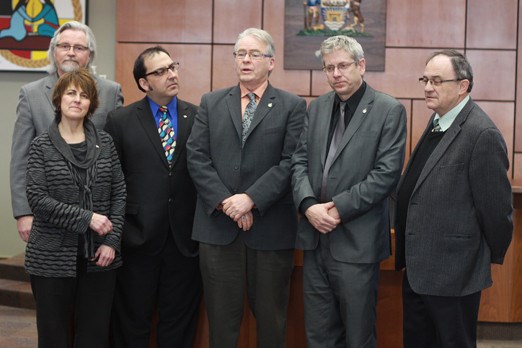Thunder Bay-Superior North is 90,000 square-kilometres and consists of 31 townships and municipalities, along with another nine First Nations; it takes NDP MP Bruce Hyer three weeks to tour the riding he represents.
Six Northern Ontario NDP MPs made official stops in Sudbury, Sault Ste. Marie and Thunder Bay Monday to inform Northerners of the seat redistribution that will happen in 2013. Thirty new seats will be added with Ontario receiving 15, six going to both British Columbia and Alberta and three to Quebec.
The NDP members are worried the changes could mean one less seat in Northern Ontario.
“Our ridings are already pretty big, so to enlarge the ridings any further up here and eliminate one seat would reduce our representation in the House of Commons and it means every MP here would be even further tasked to cover such huge ridings,” said Hyer in council chambers at city hall Monday.
Nickel Belt NDP MP Claude Gravelle will be introducing a Private Member’s Bill this week guaranteeing Northern Ontario will retain its 10 seats.
In 1995, Northern Ontario went from 15 seats to 11. In 2003, they lost another seat bringing them to 10.
Hyer said it’s gone far enough and that the issue should concern all federal political parties.
“These seats could go to any party in the future,” he said. “This is making sure families, voters, constituents in Northern Ontario have a good voice in the House of Commons.”
MP John Rafferty (NDP, Thunder Bay-Rainy River) is also concerned that losing one or two federal ridings could lessen Northern Ontario’s voice in Ottawa.
“That’s my No. 1 job, to be a voice for my constituents in Ottawa. It gets harder if the ridings get bigger,” he said.
The commission tasked with the redrawing of riding boundaries has yet to be formed and the final decisions won’t be made until next year. Rafferty said they are bringing the issue up now because they want people to be aware of what could happen so they can let their views be known.
Timmins-James Bay MP Charlie Angus (NDP) stressed the importance for Northern communities to be aware of the issue and lay down some markers.
“This is an issue where the mayors of the various municipalities really need to get involved. There will be letters to the boundary commissioners. They need to understand that when you have ridings larger than western European countries, the ability of the average Northerner to actually have representation becomes greatly diminished,” he said.
Angus said they’re not asking for special treatment. When looking at the riding distribution throughout the country, the average riding in Saskatchewan has 68,000 people; the Yukon has an average of 34,000 people. In Northern Ontario, it’s more than 90,000 people.
“If you make our ridings any bigger, people are not going to have fair access to their members of Parliament,” he said.
